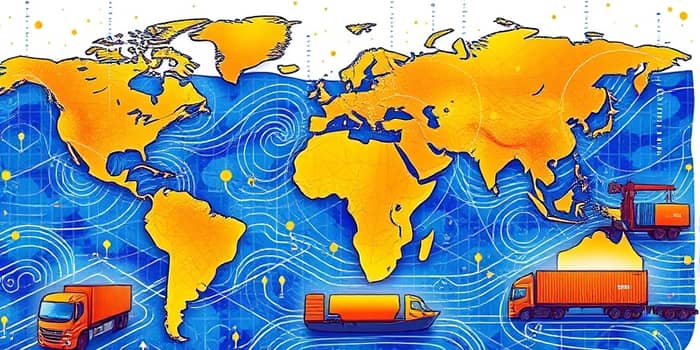
In today’s rapidly changing business landscape, the strength of a company’s supply chain defines its ability to thrive. With persistent inflation, geopolitical uncertainties, and aftershocks from the COVID-19 pandemic, firms must focus on robust frameworks that can absorb shocks and maintain operations. Ensuring maintaining operational continuity amidst unforeseen challenges has become a top strategic priority across industries.
Supply chain resilience refers to the capacity of a network to anticipate, prepare for, and adapt to disruptive events. It is not only about bouncing back but also about balance efficiency with adaptability in supply chains. In 2025, the definition extends beyond agility and risk mitigation; it involves embracing digital innovation and collaborative partnerships to build a future-ready model.
In 2025, companies contend with inflation rates hovering around 5-7% globally, while supply shortages in critical materials remain frequent. Geopolitical flashpoints, including trade disputes between major economies, have introduced fresh hurdles in cross-border logistics. At the same time, the maturation of digital technologies offers unprecedented opportunities for proactive risk management. To remain competitive, businesses must weave together strategic planning and technological innovation into a cohesive resilience framework.
Before exploring solutions, it is essential to understand the pressures facing supply chains today. Modern disruptions can be simultaneous and interrelated, ranging from economic instability to cyber threats. Recognizing these challenges allows organizations to develop targeted strategies.
The combination of economic, political, and technological pressures means that disruptions can manifest in any link of the chain, at any time. Supply shortages in semiconductors, fluctuations in shipping capacity, and cyberattacks on logistics platforms illustrate the diverse nature of modern threats. Organizations cannot address these in isolation; instead, they must adopt integrated risk management approaches that consider all potential failure points.
Developing a resilient supply chain demands a multifaceted approach. Organizations must look beyond reactive measures and embrace proactive strategies that build redundancy, visibility, and responsiveness. Effective leaders integrate risk management into every stage of product planning, procurement, and distribution.
Combining these strategies creates a dynamic defense against shocks. For example, nearshoring paired with diversified suppliers can drastically reduce the risk of single-region failures. Similarly, predictive forecasting enhances JIC inventory, cutting carrying costs while maintaining buffers.
Leadership and organizational culture play crucial roles in driving resilience. By encouraging cross-functional collaboration, continuous improvement, and shared responsibility, companies embed disruptive readiness into their DNA.
Digital tools and data-driven insights are catalysts for building resilient supply chains. Companies that harness technology effectively gain critical visibility and speed in decision-making. Leveraging AI and automation for resilience empowers teams to focus on strategic priorities rather than manual tasks.
Key technological enablers include:
Successful deployments often combine interoperability with user-friendly dashboards, enabling stakeholders at all levels to interpret data quickly. Integrating Internet of Things (IoT) sensors further enriches visibility, tracking goods in transit and predicting maintenance needs for key machinery.
To validate resilience initiatives, organizations must track key performance indicators and compare them against industry benchmarks. Recent surveys highlight the evolving priorities of supply chain leaders:
Beyond percentages, companies measure cycle times, fill rates, and supplier performance metrics to gauge resilience. Tools that automate scorecards and dashboards help teams identify trends early, enabling swift corrective actions.
Several industry leaders have demonstrated the power of resilient design. A global electronics manufacturer diversified its supplier base after facing raw material shortages, reducing downtime by 40%. Their approach to dual-sourcing critical components from multiple regions exemplifies ability to withstand disruptions and quickly recover.
In the automotive sector, a leading OEM relocated key production lines nearer to primary markets. This nearshoring strategy cut logistics lead times by 30%, improved inventory turnover, and enhanced responsiveness to local demand spikes. By blending local agility with global scale, they achieved a robust risk posture.
Meanwhile, a pharmaceutical company adopted AI-driven demand sensing to anticipate shifts in global health needs. By integrating machine learning models with its ERP system, it achieved a 25% reduction in stockouts and lowered carrying costs through optimized ordering schedules. This case underscores the importance of data-driven decision making in crisis scenarios.
True resilience emerges from partnership and shared commitment. Organizations should foster open dialogues with suppliers, logistics providers, and technology vendors. Collaborative networks enable real-time information sharing, joint innovation, and swift collective responses to disruptions.
Implementing regular joint reviews, performance scorecards, and risk-sharing agreements cements trust and aligns incentives toward mutual success. Leveraging consortium platforms and shared intelligence hubs further enhances collective readiness across industries.
Building supply chain resilience in 2025 is not a one-time project but a continuous journey. Companies that integrate strategic diversification, robust inventory practices, and cutting-edge technology will be best positioned to navigate future disruptions.
Embracing a culture of collaboration and data-driven decision making ensures that supply chains remain adaptive and responsive. Ultimately, prioritizing resilience transforms supply chains from vulnerable cost centers into dynamic engines of growth and stability, empowering organizations to thrive no matter what challenges lie ahead.
References













